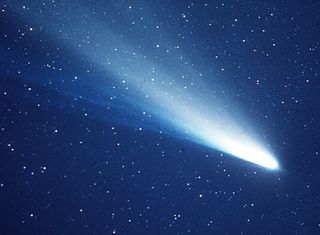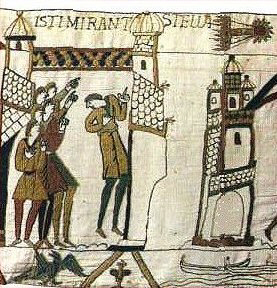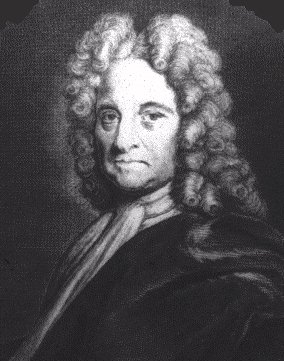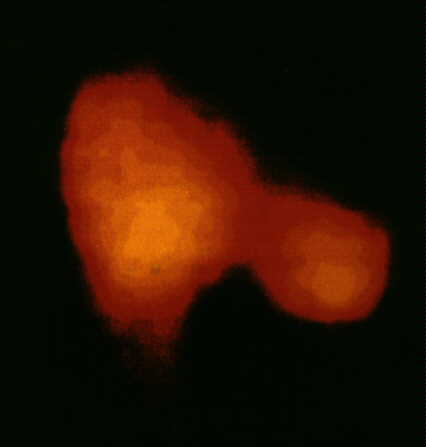What Year Will Halleys Comet Be Seen Again
Halley'southward Comet: Facts about history's almost famous comet

Halley'southward Comet is arguably the most famous comet in history.
As a "periodic" comet, it returns to Globe'southward vicinity about every 75 years, making information technology possible for a person to meet it twice in their lifetime. It was last here in 1986, and it is projected to return in 2061.
The comet, officially called 1P/Halley, is named after English astronomer Edmond Halley, who examined reports of a comet approaching Earth in 1531, 1607 and 1682. He concluded that these 3 comets were actually the same comet returning over and over once more, and predicted that it would render in 1758. Halley's calculations showed that at least some comets orbit the sun.
Halley didn't live to see the comet's correctly-predicted return, simply the comet was given his proper noun. (For those looking for help with pronunciation, the name traditionally rhymes with the word valley.)
Photos: Halley's Comet Through History
Scientists finally got an up-close look at the comet when it last visited in 1986 when several spacecraft were sent to Halley'due south vicinity to sample its limerick. High-powered telescopes likewise observed the comet as it swung by Earth.
While the comet won't be back for up-close study for decades, scientists continue to investigate comets, looking at other modest bodies. A notable example was the Rosetta probe, which looked at Comet 67P/Churyumov–Gerasimenko between 2014 and 2016 and concluded that the comet has a different kind of water than Earth's h2o.
The history of Halley's comet
The showtime known observation of Halley's Comet, or Comet Halley, took place in 239 B.C., co-ordinate to the European Space Agency. Chinese astronomers recorded its passage in the Shih Chi and Wen Hsien Thung Khao chronicles. Another study (based on models of Halley'due south orbit) pushes that beginning observation back to 466 B.C., which would have made it visible by the Ancient Greeks.
When Halley'south returned in 164 B.C. and again in 87 B.C., it probably was noted in Babylonian records now housed at the British Museum in London.
"These texts have of import begetting on the orbital move of the comet in the ancient past," a research paper in the journal Nature noted almost the tablets.

Information technology'southward also thought that another appearance of the comet in 1301 could take inspired Italian painter Giotto'south rendering of the Star of Bethlehem in "The Adoration of the Magi," co-ordinate to the Britannica encyclopedia.
Halley'south nearly famous advent occurred shortly before the 1066 invasion of England by William the Conquistador. It is said that William believed the comet heralded his success. In any case, the comet was put on the Bayeux Tapestry — which chronicles the invasion — in William'due south accolade.
Astronomers in these times, however, saw each advent of Halley'due south Comet as an isolated issue. Comets were often foreseen equally a sign of great disaster or modify.
Even when Shakespeare wrote his play "Julius Caesar" around 1600, simply 105 years before Edmond Halley calculated that the comet returns over and over again, he included a at present-famous phrase sepaking of comets as heralds: "When beggars die there are no comets seen; The heavens themselves blaze forth the death of princes."
Discovering Halley's comet
Astronomy began changing swiftly around Shakespeare'south fourth dimension, however. Many astronomers of his time believed that Globe was the centre of the solar system, merely Nicolaus Copernicus — who died nearly 20 years before Shakespeare'due south birth — published findings showing that the heart was actually the sun.
It took several generations for Copernicus' calculations to take concord in the astronomy community, but when they did, they provided a powerful model for how objects movement around the solar system and the universe.

Years passed and the comet appeared in 1531, 1607 and 1682. Halley suggested the aforementioned comet could render to Earth in 1758. Halley did not alive long plenty to meet its render (he died in 1742) only his work inspired others to name the comet later on him.
On each successive journey to the inner solar system, astronomers on Earth turned their telescopes skyward to watch Halley's approach.

The comet's pass in 1910 was peculiarly spectacular, as the comet flew by about 13.9 million miles (22.4 meg kilometers) from Earth, which is near 1-fifteenth the altitude between World and the sun. On that occasion, Halley's Comet was captured on camera for the get-go time.
According to biographer Albert Bigelow Paine, the writer Mark Twain said in 1909, "I came in with Halley'due south Comet in 1835. Information technology is coming once again adjacent year, and I expect to go out with information technology." Twain died on April 21, 1910, ane twenty-four hour period later on perihelion, when the comet emerged from the far side of the sun.
Halley-similar comets
There is a group of comets called "Halley family comets" (HFC) because they appear to share the same orbital characteristics of Halley, including beingness highly inclined to the orbits of Globe and other planets in the solar arrangement. However, this family has a range of inclinations, which prompts other astronomers to suggest they may have a different origin than Halley.
Some suggest these comets could take evolved from members of the Oort Cloud, or from Centaurs (objects that generally accept a closest arroyo betwixt Jupiter and the Kuiper Chugalug.) Alternatively, HFCs could have come from somewhere but beyond Neptune.
Sending spacecraft to Halley's comet
When Halley's Comet came by Earth in 1986, it was the outset time nosotros could send spacecraft to await at it upwards close.
That was a fortunate occurrence, every bit the comet ended up being underwhelming in observations from Earth. When the comet made its closest approach to the lord's day, information technology was on the reverse side of that star from the Globe — making information technology a faint and distant object, some 39 million miles (63 million km) abroad from Earth.
Several spacecraft successfully made the journey to the comet. This fleet of spaceships is sometimes dubbed the "Halley Fleet." Two joint Soviet/French probes (Vega ane and 2) flew nearby, with one of them capturing pictures of the nucleus, or "middle," of the comet for the showtime time.
The European Infinite Agency's Giotto craft got even closer to the nucleus, effulgent back spectacular images to Earth. Japan sent two probes of its ain (Sakigake and Suisei) that as well obtained data on Halley.
NASA's International Cometary Explorer (already in orbit since 1978) as well captured pictures of Halley, snapping its shots from 17.3 million miles (28 million km) away.
"It was inevitable that this most famous of all comets would receive unprecedented attention, but the bodily magnitude of the effort has surprised fifty-fifty well-nigh of those involved in information technology," NASA noted in an business relationship of the event.
The astronauts aboard Challenger'due south STS-51L mission were too scheduled to look at the comet. Just, sadly, they never got the chance. The shuttle exploded about two minutes after launch on Jan. 28, 1986, due to a rocket malfunction, killing all seven astronauts on board.
It will be decades until Halley's gets close to Earth again in 2061, but in the concurrently, y'all can run into its remnants every year. The Orionid meteor shower, which is spawned by Halley's fragments, occurs annually in October. Halley's also producedsa shower in May, called the Eta Aquarids.
When Halley's sweeps past World in 2061, the comet will be on the same side of the sun as Earth and volition be much brighter than in 1986. At least one study has pointed out that it is difficult to predict Halley's orbit on a scale of more than 100 years, and that the comet could collide with some other object (or be ejected from the solar organisation) in equally little as 10,000 years, although not all scientists agree with the hypothesis.
When Halley adjacent returns to Earth'southward vicinity, 1 astronomer predicted it could be equally bright equally apparent magnitude -0.three. This is relatively bright, simply it won't exist the brightest object to skywatchers equally it will be well below that of the brightest star in Globe'south heaven: Sirius, at magnitude -1.4 equally seen from Earth.
While it will be decades earlier nosotros can send some other spacecraft to Halley'southward Comet, there have several other missions that have studied comets from up close. Betwixt 2014 and 2016, for example, the Rosetta probe examined Comet 67P/Churyumov–Gerasimenko upwards close and made comparisons to other comets.
One of its primal findings was uncovering that Comet 67P had a unlike kind of water (specifically, a dissimilar deuterium-to-hydrogen ratio) than what is seen on Earth. Back in the 1980s, similar examinations of Halley by the Giotto probe likewise showed that Halley has a dissimilar D-to-H ratio in its water than on Earth.
Other notable cometary missions include NASA's Stardust (which captured samples of comet 81P/Wild and returned them to Earth), NASA'due south Deep Affect (which deliberately sent an impactor into 9P/Tempel on July iv, 2005), and the European Space Agency'southward Philae (which landed on Comet 67P in 2014.)
This reference page was updated on Jan. eleven, 2022 past Space.com senior writer Chelsea Gohd.
Additional resources
- How to photograph Comet NEOWISE: NASA tips for stargazers
- Comet Leonard volition low-cal upwards the sky this calendar month — here's how to see it
- Astonishing photos of Comet NEOWISE from the Earth and space
Join our Space Forums to proceed talking infinite on the latest missions, night heaven and more! And if yous accept a news tip, correction or comment, permit us know at: community@space.com.
Source: https://www.space.com/19878-halleys-comet.html

Post a Comment for "What Year Will Halleys Comet Be Seen Again"